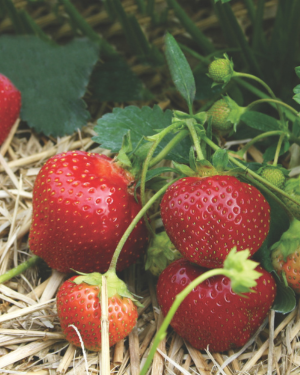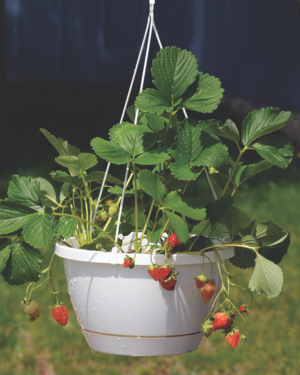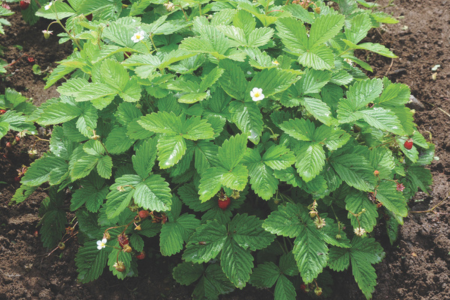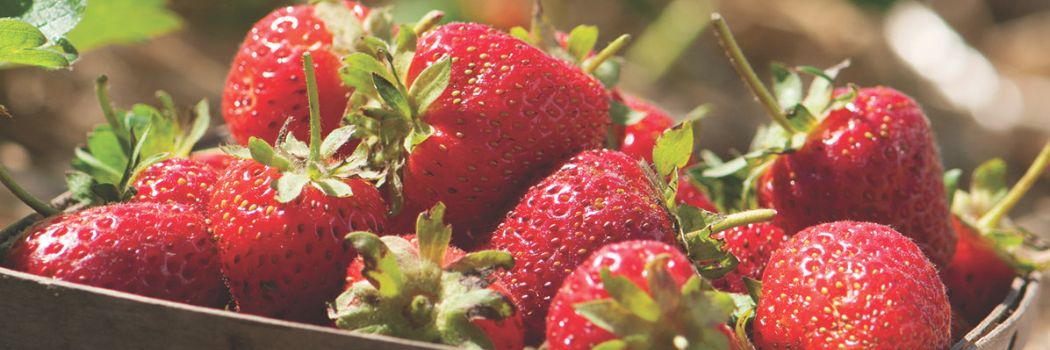- Strawberries | Instructions for Growing from Seed, including Traditional & Alpine Strawberries | Tech Sheet (PDF)
- Basics of Growing Hoophouse Strawberries, by Lynn Byczinski
- Summer-Bearing / June-Bearing Strawberries | Key Growing Information
- Day-Neutral / Everbearing Strawberries | Key Growing Information
- Unboxing and Caring for Your Strawberry & Raspberry Fruit Plants
- Strawberry Succession Planting/Harvesting Program
- Strawberries | Instructions for Growing in Hanging Containers from Bare-root Plants | Tech Sheet (PDF)
- Strawberries | Instructions for Growing from Bare-root Plants | Tech Sheet (PDF)
- 3 Main Types of Strawberries: Tips for Selecting Which Types to Grow
Tips for Selecting Which Types of Strawberries to Grow
Strawberries are one of the most popular fruits in American gardens and market farms. They can be grown in many different places and ways, from hanging baskets to fields, hoophouses to vertical farming. The trick is to match your growing system and harvest window to the type of strawberry you want to grow. For example, some varieties need plenty of space, whereas others can be grown in containers. Here is a quick overview of the basic differences and production options for the three main types.
June-Bearing Strawberry Varieties (a.k.a. Summer Fruiting Varieties)

Harvest window
June-bearing varieties are the earliest type to fruit, producing berries all at once as a single crop in June, or earlier in warmer climates. These types initiate fruit buds in fall and blossom the following spring. They produce one crop and then expend energy vegetatively propagating by sending out runners, also called daughter plants, that will fruit the following year.
Establishment
June-bearing plants require a full establishment year during which you will remove all flower buds to encourage the plant to put its energy into becoming established. By doing so, the plant will yield a larger crop the following—or first-bearing—year.
Renovation
Renovation is a process performed on beds of summer-fruiting varieties to maintain plant health and production. Expect to renovate your June-bearing strawberry beds every year starting in year two. Beds will fruit for 3-5 years before needing to be replanted. For more details, please see our Strawberry Production Guide.
Growing Instructions for June-Bearing Strawberries
- June-Bearing Strawberries • Key Growing Information
- Strawberry Production • Instructions for Growing from Dormant Bare-root Plants • Tech Sheet (PDF)
Everbearing & Day-Neutral Strawberry Varieties

Harvest window
Everbearing and day neutral are terms that are often used interchangeably, but there are some subtle differences that set them apart.
During their first year in Northern climates, everbearing strawberry types generally begin to flower in the late spring/early summer, and again in late summer/early fall. Spring flowers form fruit September through November and late summer flowers form fruit the following spring.
In the South, they can begin to flower late Winter and will form fruits in early Spring until temperatures become inhospitably hot. They will begin to form flowers again in late Summer/Early Fall and form fruit through October if conditions are favorable.
Day neutral types are essentially more productive everbearing strawberries. Day neutral varieties are less influenced by day-length. In the North, they flower in early spring and form fruits through the summer months during their first year, and in the South they flower in late winter and form fruits throughout the Spring and again in the Fall of their first year. Day neutral types are usually grown as an annual, but if successfully overwintered, while somewhat less productive, will produce again for a second year.
Establishment
Unlike June-bearing plants, everbearing & day neutral plants do not need a full year for establishment, thus you can enjoy fruit their first year. Remove all of the flower buds for the first 6 weeks after setting out your plants, then allow the plants to flower and fruit.
While typically planted in the spring, fall planting is suitable in regions with mild winters (generally Zones 7 and higher). Fall-planted strawberries often exhibit more vigorous growth, leading to an earlier harvest in the spring, often eliminating the need for a typical spring establishment period. For more information, see our growing instructions below.
Day-neutral beds will last for one to two growing seasons once established. Do not renovate day-neutral varieties.
Growing Day-Neutral varieties in Containers
Day-neutral and everbearing strawberries are good for container production on a deck or patio. Some varieties, for example, 'Seascape', will fruit on unrooted runners, so they make attractive hanging baskets, with the runner plants cascading over the sides of the basket.
Growing Instructions for Day-Neutral Strawberries
- Day-Neutral (Everbearing) Strawberries • Key Growing Information
- Strawberry Production • Instructions for Growing from Dormant Bare-root Plants • Tech Sheet (PDF)
- Strawberry Production • Instructions for Growing in Hanging Containers from Bare-root Plants • Tech Sheet (PDF)
Alpine Strawberries

Alpine strawberries, such as 'Alexandria', are a type that produces small but intensely flavorful berries. They do not send out many runners and are usually grown from seed. Most alpine types are day neutral or everbearing.
Alpine types work well in strawberry pots, window boxes, and other containers, or as edging in the vegetable, herb, or ornamental garden. They also can be grown with less than full sun, so they are a good choice for many home gardeners.
Growing Instructions for Alpine Strawberries
Learn More
Varieties differ in hardiness, so be sure to match your growing zone to the range of zones listed for each variety. Region-specific growing information is available from most state extension services.
For information on growing under certified-organic conditions, see the publication from ATTRA titled Strawberries: Organic Production.
To learn how to produce a season-long, sequential strawberry harvest, see our Strawberry Planting/Harvesting Program.


